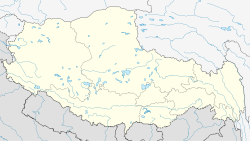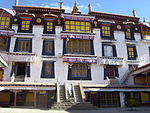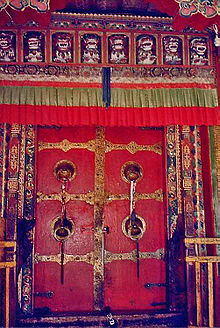- Drepung Monastery
-
Drepung Monastery 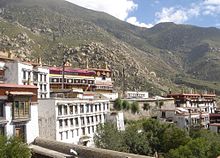
Drepung MonasteryTibetan name Tibetan འབྲས་སྤུངས་ Wylie transliteration ’bras spungs pronunciation in IPA [[tʂɛpuŋ]] official transcription (PRC) Zhaibung THDL Drepung other transcriptions Dräpung, Drebung Chinese name traditional 哲蚌寺 simplified 哲蚌寺 Pinyin Zhébàng Sì Coordinates: 29°40′35″N 91°2′51″E / 29.67639°N 91.0475°E Monastery information Location Mount Gephel, Lhasa Prefecture, Tibet, China Founded by Jamyang Chojey Founded 1416 Type Tibetan Buddhist Sect Gelug Dedicated to Je Tsongkhapa Colleges 7 - Gomang, Loseling, Deyang, Shagkor, Gyelwa or Tosamling, Dulwa and Ngagpa Drepung Monastery (wylie: 'bras spungs dgon [1]),(literally “Rice Heap” monastery[2][3]), located at the foot of Mount Gephel, is one of the "great three" Gelukpa university monasteries of Tibet. The other two are Ganden and Sera.
Drepung is the largest of all Tibetan monasteries and is located on the Gambo Utse mountain, five kilometers from the western suburb of Lhasa.
Freddie Spencer Chapman reported, after his 1936-37 trip to Tibet, that Drepung was at that time the largest monastery in the world, and housed 7,700 monks, "but sometimes as many as 10,000 monks."[4]
Since the Chinese invasion and occupation of Tibet in the 1950s, Drepung Monastery, along with its peers Ganden and Sera, have lost much of their independence and spiritual credibility in the eyes of Tibetans since they operate under the close watch of the Chinese security services. All three were reestablished in exile in the 1950s in Karnataka state in south India. Drepung and Ganden are in Mundgod and Sera is in Bylakuppe.
Contents
History
It was founded in 1416 by Jamyang Choge Tashi Palden (1397–1449), one of Tsongkhapa's main disciples, and it was named after the sacred abode in South India of Shridhanyakataka.[5] Drepung was the principal seat of the Gelugpa school and it retained the premier place amongst the four great Gelugpa monasteries.[6] The Ganden Podang (dga´ ldan pho brang) in Drepung was the residence of the Dalai Lamas until the Great Fifth Dalai Lama constructed the Potala.Drepung was known for the high standards of its academic study, and was called the Nalanda of Tibet, a reference to the great Buddhist monastic university of India.
Old records show that there were two centres of power in Drepung: the so-called lower chamber (Zimkhang 'og ma) [7] associated with the Dalai Lamas-to-be, and the upper chamber (Zimkhang gong ma) associated with the descendants of Sonam Drakpa, an illustrious teacher who died in 1554.[8] The estate of the Dalai Lamas at Drepung monastery, called Ganden Phodrang, had been constructed in 1518 by Gendun Gyatso Palzangpo (1476–1541), retrospectively named and counted as 2nd Dalai Lama.
Penchen Sönam Drakpa (1478-1554 CE) in 1535 succeeded Gendün Gyatso (1476–1541) on the Throne of Drepung, both of them being major figures in the history of the Geluk tradition. By the time Sönam Drakpa was appointed to the Throne of Drepung (Drepung Tri), he was already a famous Geluk master. He had already occupied the Throne of Ganden (Ganden Tri) and was considered the most prolific and important Geluk thinker of his time. His successor was none other than Sönam Gyatso (1543-1588 CE), the lama who would receive the official title of the Third Dalai Lama (Talé Lama Kutreng Sumpa).
Before his death in 1554, Sönam Drakpa established his own estate, the Upper Chamber (Zimkhang Gongma), which was named because of its location at the top of Drepung, just below the Ngakpa debating courtyard "Ngagpa Dratshang".
Tibetan Buddhist Resource Center attributes the following Name variants to Penchen Sönam Drakpa: "bsod nams grags pa [primaryName], paN chen bsod nams grags pa [title], khri 15 bsod nams grags pa [primaryTitle], rtses thang paN chen bsod nams grags pa [title], gzims khang gong ma 01 bsod nams grags pa [title], this last one referring to the Seat of the Upper Chamber established in 1554.[9] According to TBRC his successors referring to the estate of the Zimkhang Gongma were Sonam Yeshe Wangpo (1556–92),[10] Sonam Gelek Palzang (1594–1615)[11] and Tulku Dragpa Gyaltsen (1619–1656)[12] - closely connected to the famous story of Dorje Shugden. (Some say that Drakpa Gyeltsen was Sönam Drakpa’s second reincarnation,[13] but usually he is considered to be the 4th incarnation of Panchen Sonam Dragpa [14]). It seems to be commonly accepted that Dragpa Gyaltsen was the fourth holder of the gzims khang gong ma incarnation line. According to Tibetan Buddhist Resource Center gzims khang gong ma 04 grags pa rgyal mtshan has been his "primaryTitle".[15] Since the search for his reincarnation has been banned, he has been the last one.
Chapman reported that in the late 1930s Drepung was divided into four colleges, each housing monks from a different locality: "one being favoured by Khampas, another by Mongolians, and so on." Each college was presided over by an abbot who had been appointed by the late 13th Dalai Lama.[16]
Drepung is now divided into what are known as the seven great colleges: Gomang (sGo-mang), Loseling (Blo-gsal gling), Deyang (bDe-dbyangs), Shagkor (Shag-skor), Gyelwa (rGyal-ba) or Tosamling (Thos-bsam gling), Dulwa (‘Dul-ba), and Ngagpa (sNgags-pa). It can be a somewhat useful analogy to think of Drepung as a university along the lines of Oxford or the Sorbonne in the Middle Ages, the various colleges having different emphases, teaching lineages, or traditional geographical affiliations.
According to local sources, today the population at the monastery in Lhasa is about 300 monks, due to population capping enforced by the Chinese government. However, the institution has continued its tradition in exile with campuses in South India on land in Karnataka given to the Tibetan community in exile by Prime Minister Nehru. The monastery in India today houses over 5,000 celibate monks, with around 3,000 at Drepung Loseling and some 2,000 at Drepung Gomang. Hundreds of new monks are admitted each year, many of them refugees from Tibet.
The Ganden-Phodrang-Palace situated at Drepung Monastery was constructed by the 2nd Dalai Lama in 1518 [17] and declared his chief residence/governmental palace until the inauguration of Potala Palace by the 5th Dalai Lama.
Recent events
About 40% of the old monastic town was destroyed after the Chinese arrived in Lhasa in 1951, though luckily the chief buildings including the four colleges, the Tsokchen and the Dalai Lamas' residence were preserved.[6]
Drepung monastery was shut by Chinese authorities on 14 March 2008, after monk-led protests against Chinese rule turned violent and businesses, shops and vehicles were looted and torched. The PRC claims that 22 people were killed in the riots but Tibetan sources put the figure much higher. It was reopened in the last week of August after being shut for five months.[18]
Part of a series on Tibetan Buddhism
History Timeline · Related-topics Schools Nyingma · Kagyu · Sakya · Gelug · Bön · Jonang Key concepts Three marks of existence · Skandha · Cosmology · Saṃsāra · Rebirth · Bodhisattva · Dharma · Dependent origination · Karma Major figures Gautama Buddha · Padmasambhava · Je Tsongkhapa · Dalai Lama · Panchen Lama · Lama · Karmapa Lama · Rinpoche · Geshe · Terton · Tulku Buddhahood · Avalokiteśvara · Four stages of enlightenment · Tantric yoga · Paramitas · Meditation · Laity Changzhug · Drepung · Dzogchen · Ganden · Jokhang · Kumbum · Labrang · Mindroling · Namgyal · Narthang · Nechung · Pabonka · Palcho · Ralung · Ramoche · Sakya · Sanga · Sera · Shalu · Tashilhunpo · Tsurphu · Yerpa Chotrul Duchen · Dajyur · Losar · Monlam · Sho Dun Texts Kangyur · Tengyur · Tibetan canon · Mahayana sutras · Nyingma Gyubum Sand mandala · Thangka · Ashtamangala · Tree of physiology Outline · Comparative studies · Culture · List of topics · Portal
Footnotes
- ^ TBRC
- ^ Tibet, Tibet: A Personal History of a Lost Land. Patrick French. (2003) Alfred A. Knopf. New York City, p.240 (in quote from 13th Dalai Lama).
- ^ Dialogues Tibetan Dialogues Han. Hannue. Quoting a monk at Drepung.
- ^ Chapman F. Spencer. Lhasa the Holy City, p. 195. Readers Union Ltd., London.
- ^ Dorje (1999), p. 113.
- ^ a b Dowman (1988), p. 67.
- ^ gong ma 'og ma - the higher and the lower, the one above and the one under
- ^ [1]
- ^ TBRC
- ^ , TBRC bsod nams ye shes dbang po (gzims khang gong ma 02)
- ^ TBRC bsod nams dge legs dpal bzang (gzims khang gong ma 03)
- ^ TBRC grags pa rgyal mtshan (gzims khang gong ma 04)
- ^ Drepung: An Introduction by Georges Dreyfus (April 10, 2006)
- ^ Brief History of Ganden
- ^ TBRC
- ^ Chapman F. Spencer. Lhasa the Holy City, p. 198. Readers Union Ltd., London.
- ^ [2] (german)
- ^ Major Buddhist monastery reopens in Tibet. The Associated Press
References
- Dorje, Gyurme. (1999). Footprint Tibet Handbook with Bhutan. 2nd Edition. Footprint Handbooks. Bath, England. ISBN 0-8442-2190-2.
- Dowman, Keith. (1988). The Power-places of Central Tibet: The Pilgrim's Guide. Routledge & Kegan Paul, London and New York. ISBN 0-7102-1370-0
See also
- Google Map of Drepung
- Bras-spungs monastery, Tibet, China Encyclopædia Britannica
- An multimedia guide to Drepung
- Drepung Loseling Institute in North America
- A Brief History of Drepung Monastery
- Drepung: An Introduction by Georges Dreyfus (April 10, 2006)
- The Gomang College home page
Lhünzhub · Damxung · Nyêmo · Qüxü · Doilungdêqên · Dagzê · Maizhokunggar · Chengguan District
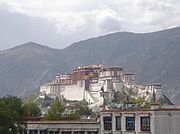
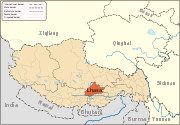
Towns and villages Monasteries
and palacesArchitecture of Lhasa · Lingkhor · Potala Palace · Norbulingka · Jokhang Temple · Tsomon Ling · Ganden Monastery · · Kundeling Monastery · Nechung · Nyethang Drolma Lhakhang Temple · Yangpachen Monastery · · Drepung Monastery · Ramoche Temple · Reting Monastery · Sanga Monastery · Yerpa
Sera Monastery: · Chupzang Nunnery · Drakri Hermitage · Garu Nunnery · Jokpo Hermitage · Keutsang Hermitage · Keutsang East Hermitage · Keutsang West Hermitage · Khardo Hermitage · Negodong Nunnery · Nenang Nunnery · Pabongkha Hermitage · Panglung Hermitage · Purbuchok Hermitage · Rakhadrak Hermitage · Sera Chöding Hermitage · Sera Gönpasar Hermitage · Sera Utsé Hermitage · Takten Hermitage · Trashi Chöling HermitageOther landmarks Banak Shöl Hotel · Barkhor · Chokpori · Drapchi Prison · Lhasa Brewery · Lhasa Hotel · Lhasa Zhol Pillar · Tibet Museum · Tibet University · Tromzikhang · Nyang bran · Hutoushan ReservoirTransport Lhasa Airport · Damxung Railway Station · Lhasa Railway Station · Lhasa West Railway Station · Wumatang railway station · Yangbajain Railway Station · G109 · G318 · North Linkor RoadGovernment Doje Cezhug · Jigme Namgyal
Buddhist monasteries in Tibet Lhasa Prefecture Ani Tsankhung Nunnery · Drepung Monastery · Drigung Monastery · Ganden Monastery · Jokhang · Kundeling Monastery · Muru Nyingba Monastery · Namgyal Monastery · Nechung · Nyethang Drolma Lhakhang Temple · Ramoche Temple · Reting Monastery · Sanga Monastery · Taklung Yarthang Monastery · Tradruk Temple · Tsomon Ling · Tsurphu Monastery · Yangpachen Monastery · Yerpa · Zhuowaqudeng Monastery
Sera Monastery: · Chupzang Nunnery · Drakri Hermitage · Garu Nunnery · Jokpo Hermitage · Keutsang Hermitage · Keutsang East Hermitage · Keutsang West Hermitage · Khardo Hermitage · Negodong Nunnery · Nenang Nunnery · Pabongkha Hermitage · Panglung Hermitage · Purbuchok Hermitage · Rakhadrak Hermitage · Sera Chöding Hermitage · Sera Gönpasar Hermitage · Sera Utsé Hermitage · Takten Hermitage · Trashi Chöling HermitageShannan Prefecture Shigatse Prefecture Changmoche Monastery · Lhatse · Chokorgyel Monastery · Daklha Gampo · Dorje Pakmo · Drongtse Monastery · Donggar Monastery · Garju Monastery · Manmogang Monastery · Menri Monastery · Milarepa's Cave · Narthang Monastery · Ngor · Palcho Monastery · Ralung Monastery · Samding Monastery · Sakya Monastery · Ṣalu Monastery · Shelkar · Tashilhunpo · Tsi Nesar · Tsechen Monastery and DzongNgari Prefecture Chamdo Prefecture
and former KhamGalden Jampaling Monastery · Karma Gon Monastery · Benchen Monastery · Dorje Drak · Dzogchen Monastery · Dzongshar Monastery · Kandze Monastery · Katok Monastery · Nanwu Si Monastery · Palyul · Riwoche Monastery · Shechen Monastery · Surmang · Tongkor ·Nyingchi Prefecture Categories:- Buddhist monasteries in Tibet
- Buddhist temples in Tibet
- 1416 establishments
- Religious organizations established in the 1410s
- 1410s architecture
- Lhasa Prefecture
- Gelug monasteries
Wikimedia Foundation. 2010.

